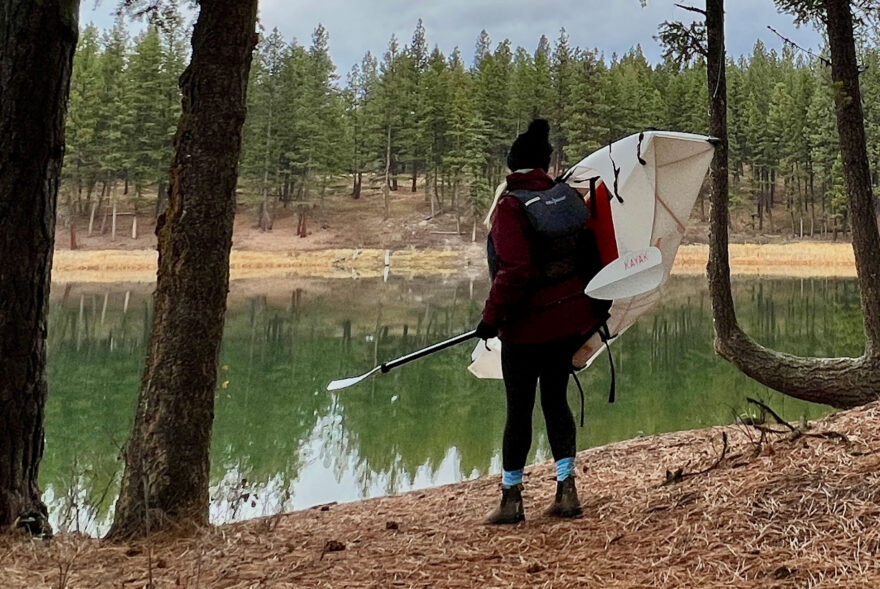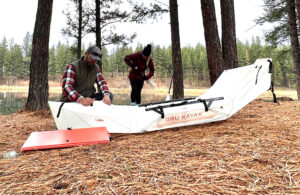
Image by Suzanne Downing
If you’ve ever loaded a kayak onto the top of your car and strapped it down, then gone through the process of unloading it at your destination, you know the effort it takes. You also know how much space it takes to store a kayak when not in use. The foldable Oru Kayak Lake+ is an innovative solution to streamlining your adventures on the water.
The Oru folding kayak design first surfaced in 2012 on Kickstarter after inventor Anton Willis — avid paddler and architect grad — started playing around with a foldable design when his old fiberglass kayak wouldn’t fit into his small apartment. Bottom line: Willis wanted a kayak he could store in his closet.
Ardy Sobhani, a design strategist, and Roberto Gutierrez, an outdoor product sales pro joined Willis in his quest to perfect his design. Shortly after the team brought the first Oru kayak to life. The trio appeared on Season 5, Episode 28 of Shark Tank in 2014, where they landed a deal with investor Robert Herjavec.
Today, Oru has become increasingly popular and known for offering the world’s best origami-inspired kayak. More than a decade later, you can choose from eight foldable Oru kayak models ranging in price from $499 (for their lightest most portable Lake model) to $1,999 (for their largest two-paddler Haven TT model).
We got to spend a lot of time on the water in the Oru Kayak Lake+, which retails for $699. Here’s a review of our experience and our thoughts on everything we discovered about this kayak:

Image by Suzanne Downing
Unboxing & Unfolding
Out of the box, the Lake+ Kayak arrives folded. The folded kayak is surprisingly smaller than anticipated — like an oversized garment bag — with a folded measurement of 42-by-10-by-18 inches. Coming in two boxes, the Lake+ kayak, Oru paddle, gel seat, kayak pack (a “backpack-style” kayak carrying case) and PFD (personal floatation device) were all intact and at first impression appeared made from high-quality materials.
Before heading out to open water, I practiced unfolding and assembling the kayak indoors. Since you don’t need any tools, and the assembly video (the link is included in paperwork) helps guide you along with Oru’s step-by-step instructions, and the process was straight-forward. The most challenging part was figuring out the exact positioning of the interior seat and floorboard. After a few trial-and-error attempts for the seat positioning, I got it to fit perfectly. (Tip: Make sure the seat is facing the front and not the back.)
The built-in adjustable straps used for assembling the kayak are easy to secure and intuitive. The foot bar is also easy to install and adjust as it is engineered with two anchor points and a stretchy hook-style bungee attachment. The origami inspiration of this kayak is evident, and the fold patterns reminded me of the paper folds used to make animal figures out of paper in art class as a child.
After assembling and disassembling the kayak a couple of times indoors, I felt confident I could assemble and disassemble it outdoors. It may take you three to five minutes your first few times, but then it’ll be like clockwork and you should be able to assemble it outdoors in just moments.
Lake+ Kayak Specs & Measurements
- Weight: 18 lbs.
- Length: 9’0”
- Width: 32″
- Cockpit: 66″x24″
- Max paddler height: 6’4″
- Weight capacity: 250 lbs.
- Kayak box (folded): 42″x10″x18″

Image by Suzanne Downing
Material Overview
With a minimalist design, the overall material feels durable while also being extremely lightweight at just 18 pounds. The 5 mm double-layered custom-extruded polypropylene material is about as thick as five sheets of paper stacked together. Oru’s engineers put a 10-year UV treatment on the exterior, so you don’t have to worry about the sun breaking down (or melting) the shell of your kayak on hot days.
With proper care (like wiping off excess water and rinsing your kayak with fresh water and folding it when it’s dry when you’re done paddling) the material can withstand use (even sliding over rough surfaces like rocks) for many years.
The material used for the Lake+ kayak can support up to 250 pounds and can be folded and unfolded around 20,000 times — allowing you to kayak 1,000 times a year for 20 years or 500 times a year for 40 years, as examples. The material is also puncture and abrasion resistant, so it’s like having an iron-man suit for your kayak.

Image by Suzanne Downing
Transporting
Transporting the Lake+ kayak is easy. Since it’s compact when folded, you can fit this kayak into the trunk of a car or in the backseat of even a compact car. Once you arrive at your destination, if you have a short distance to the water, you can carry the kayak folded (like a briefcase) with the built-in handle. For longer distances, the Oru Kayak Pack is a nice upgrade as it has adjustable shoulder straps (like a backpack) and an adjustable hip strap system so you can carry your kayak on your back comfortably. The pack also has an outer pocket for a paddle.

Image by Suzanne Downing
Setting Up Outdoors
After practicing assembling and disassembling this kayak indoors, it’s simple to assemble outdoors. And it’s as cool as it looks online. With anything you’re trying for the first time, practice makes perfect. Once you have your adjustments made, like your backrest and foot bar, you can leave those adjustments as your preferred settings, meaning you don’t have to adjust them every time you reassemble the kayak.

Image by Suzanne Downing
Getting to the Water
Unlike traditional hard sided kayaks that are much heavier than 18 pounds, you don’t want to drag this kayak to the water. There is a built-in handle on the side or you can carry it over your shoulder, which was more comfortable for me and my arm strength. Carrying versus dragging helps preserve and protect the kayak’s shell so it can last you decades.

Image by Suzanne Downing
On the Water Performance
On the water, the Lake+ kayak feels stable. You don’t sit too low in the water, and the ride gives you a balanced feel. The stability is like a traditional hard-shell kayak, but I found that this kayak wasn’t as wobbly as my traditional kayak, likely because the Lake+ is much wider at around 32 inches.
Paddling this kayak on the water feels smooth and would be easy for even a beginner paddler. This kayak also gives you nice tracking. Tracking is like staying on a straight path without veering, similar to riding a bike smoothly along a straight road without wobbling to the side. A kayak with good tracking goes forward in a straight line when you paddle so you have better control and you can have a nice relaxing experience.
This kayak is built for calm lakes and ponds, meandering rivers and mild coastal waters. If you’re an intermediate or advanced kayaker who paddles on rough water, Oru has other kayak models available that would be better for those environments.

Image by Suzanne Downing
Comfort and Ergonomics
Using Oru’s gel seat atop the padded stock kayak seat gives this kayak added comfort. The backrest is nice and gives plenty of back support for hours on the water. A nice addition to this kayak (a step up from the base model) is the adjustable foot bar. If you’ve ever kayaked, you know how much comfort comes from being able to rest your feet and bend your knees a bit on the water.
Paddling in this kayak is also comfortable. When you paddle, you typically go through a series of strokes on both sides of the kayak to propel it forward. The width of your paddle strokes vary depending on the stroke you’re using and your paddling technique. For example, when doing a regular forward stroke, you’ll reach your paddle out in the water to about where your feet, dip the blade in and use your core muscles to twist your body while keeping your paddle close to the kayak to go straight. Repeat on the other side.
A regular forward stroke is easy to do in this kayak. Turning and paddling backwards are also easy to do once you get your strokes dialed into the width of the kayak.

Image by Suzanne Downing
Final Thoughts
The main appeal of this kayak is portability. It’s easy to store and it’s easy to transport to the water. Because you can transform this kayak from a folded “box” to a functioning kayak in a few minutes it’s an obvious choice for someone with limited storage and you don’t need a roof rack to go kayaking.
The material is durable, and the ride is smooth. It’s lightweight and easy to carry without compromising quality. With proper care, this kayak can withstand obstacles on and in the water and should withstand the rigors of regular use.
One drawback to the Lake+ could be accessibility. Since the Lake+ kayak is smaller than most of Oru’s other kayak offerings, it’s limited to 250 pounds (including gear) and limited to people under 6 feet, 4 inches tall. This kayak may also be difficult for someone with limited mobility to assemble and disassemble without assistance.
Overall, I’d recommend this kayak for a beginner and intermediate paddler. It’s a great starter kayak for kids, too! And there is plenty of room to take your child or furry friend onboard comfortably in the kayak’s cockpit.
Suzanne Downing is an outdoor writer and photographer in Montana with an environmental science journalism background. Her work can be found in Outdoors Unlimited, Bugle Magazine, Missoulian, Byline Magazine, Communique, MTPR online, UM Native News, National Wildlife Federation campaigns and more.
 Your Privacy Choices
Your Privacy Choices